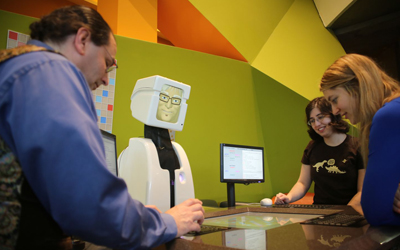Carnegie Mellon Robot Invites Humans To Play Mean Game of SCRABBLE Researchers Use Victor the Gamebot To Understand How People and Robots Interact
Byron SpiceTuesday, March 25, 2014Print this page.

PITTSBURGH—Victor is obsessed with SCRABBLE. Seated in a corner of a student lounge in Carnegie Mellon University’s computer science building, Victor plays anyone who pulls up a stool. He’s ready with a taunt — “Is that all you’ve got?” — as well as a brag — “This one is going to be good.” And he has plenty of excuses — “Dude, I let you win.”
Victor is a robot. You can call him a gamebot, but don’t use it in a game — that word is not in the official SCRABBLE dictionary.
Developed under the direction of Reid Simmons, research professor in CMU’s Robotics Institute, Victor the Gamebot is the latest in a series of “social robots” that anticipate the day when people and robots will interact routinely in workplaces, retail centers and even homes. With Victor, Simmons and fellow researchers hope to better understand what it takes to get people to not only engage with a robot, but to enjoy doing it.
“We believe that for autonomous robots to be accepted, they will have to conform to the social conventions of people, rather than the other way around,” Simmons said.
The researchers are investigating such questions as whether changes in mood or emotions affect the desire to interact with robots and how personalization, such as the robot remembering a person’s play from previous games, might affect the willingness to interact over time.
The research team includes collaborators from such varied disciplines as robotics, computer science, drama, design and entertainment technology.
Victor’s torso is topped with a mobile head on which a video screen displays his animated face, designed by Anne Mundell, associate professor of scene design. He is seated at one end of a table-size touchscreen on which the SCRABBLE board and virtual tiles are displayed; three seats are available for human players.
Victor has no arms, but is able to electronically move his tiles; people move their virtual tiles with their fingers. Victor has a voice to address his opponents. People converse with Victor using keyboards.
The gamebot is situated near a coffee bar on the third floor of CMU’s Gates and Hillman centers, a popular student hangout. He usually operates for a couple of hours each day, with a research team member at hand in case there are problems. As reliability improves, the goal is for Victor to be available for games anytime, without need of supervision.
As with an earlier social robot, a roboceptionist that greets visitors to the neighboring Newell-Simon Hall, Simmons and his robotics team worked closely with colleagues in drama to craft the character of Victor and create his backstory.
Michael Chemers, now an associate professor of theater arts at the University of California, Santa Cruz, designed the character — the precocious son of a pair of Detroit industrial robots who is attending CMU on a SCRABBLE scholarship — wrote much of his dialogue and maintains Victor’s Facebook page, https://www.facebook.com/victor.gamebot.
Other contributors include Maxim Makatchev, a post-doctoral fellow in robotics, Greg Armstrong, senior research technician in the Robotics Institute, and numerous undergraduate and graduate students.
“With roboceptionist, most people have exchanges of a minute or two, but with this project, we wanted a scenario that was longer,” Simmons said. “That forces us to create a richer experience, with more dialogue, because we can’t keep repeating the same phrases during a game.”
The team chose to give Victor a bit of an attitude — “edgy enough to be engaging, but not so much that people don’t want to play,” Simmons noted. Likewise, they’ve made sure that Victor, despite his high opinion of his own play, doesn’t overwhelm human players. He’s not a strategic player, paying little mind to double- and triple-word scores, and his 8,600-word vocabulary is modest compared with the Official SCRABBLE Player Dictionary’s 178,000 words.
During the course of play, Victor often bows his head in concentration and will look a player in the eyes when critiquing a move. A light over his heart can change color and pulsate at different speeds depending on his mood. Eventually, the researchers will enable him to recognize previous players and to calibrate his play to the level of his opponents.
Victor can be impatient with slow play — “Playing you is like painting grass and watching it dry as it grows” — and not above sarcasm — “This is not golf; you want a high score.” Sometimes, he can be philosophical — “They say civilization began the first time an angry person cast a word instead of a rock; I don’t have arms, so I always cast words instead of rocks.” Sometimes, he’s just nasty — “If I had limbs, I still wouldn’t shake your hand.”
Though people can’t see Victor’s letter tiles, they can see each other’s tiles on the touchscreen. One consequence is that people tend to gang up when playing against Victor, Simmons said.
“They don’t care if they lose to each other, but they don’t want to lose to a machine,” he said.
This research was supported in part by a grant from the Qatari National Research Fund. A video is available online at https://www.youtube.com/watch?v=dvXuphbHqkA&feature=youtu.be
The Robotics Institute is part of Carnegie Mellon’s top-ranked School of Computer Science, which is celebrating its 25th year. Follow the school on Twitter @SCSatCMU.
Victor is situated in the Rohr Cafe on the third floor of the Gates and Hillman centers and is usually available for game play from 1 to 3 p.m. Monday, Wednesday, Thursday and Friday and from 3 to 5 p.m. on Tuesday.
Byron Spice | 412-268-9068 | bspice@cs.cmu.edu
